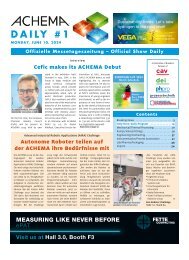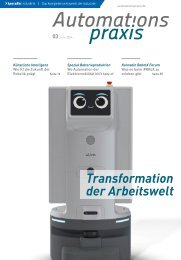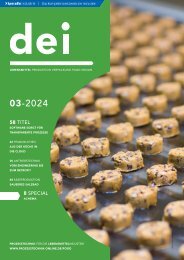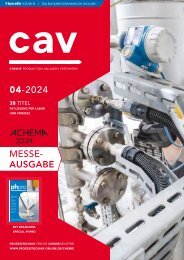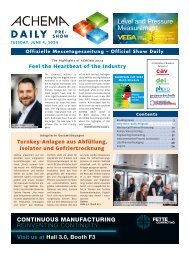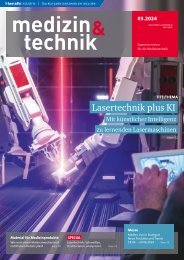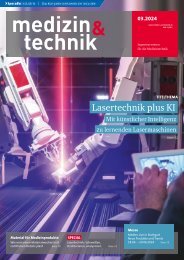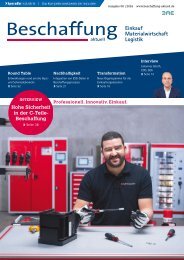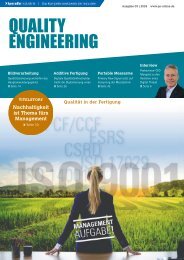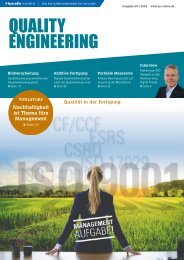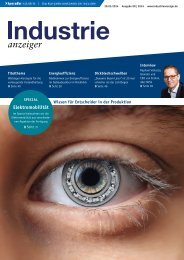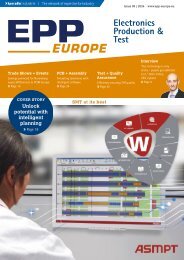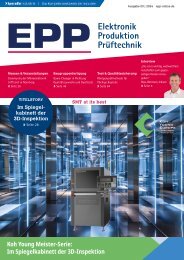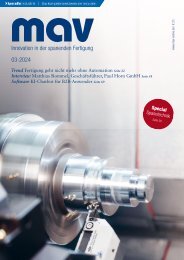cpp – Process technology for the chemical industry 01.2019
The journal cpp - Process technology for the chemical industry reports about processes, plants, apparatus and components for the chemical and pharmaceutical industry. Further topics are IT technologies, industry 4.0, digital production, MSR and automation technology and process analysis technology. The content spectrum is rounded off by explosion protection, plant safety, occupational health and safety, maintenance, site management and energy management.
The journal cpp - Process technology for the chemical industry reports about processes, plants, apparatus and components for the chemical and pharmaceutical industry. Further topics are IT technologies, industry 4.0, digital production, MSR and automation technology and process analysis technology. The content spectrum is rounded off by explosion protection, plant safety, occupational health and safety, maintenance, site management and energy management.
You also want an ePaper? Increase the reach of your titles
YUMPU automatically turns print PDFs into web optimized ePapers that Google loves.
Typical compressor map: electric actuators enlarge <strong>the</strong> operating area<br />
Advantages of electric actuation vs. pneumatic actuation in terms of speed<br />
and control accuracy<br />
stance if precise control must be reconciled<br />
with speed. Driven by a desire to satisfy all<br />
possible requirements, Festo extended its<br />
product portfolio <strong>for</strong> factory automation<br />
from pneumatic components and solutions<br />
to also include electric automation.<br />
The requirements of <strong>the</strong> O&G <strong>industry</strong> must<br />
likewise be met by all new products, namely<br />
operational reliability and of course fail-safe<br />
behaviour, in o<strong>the</strong>r words if all auxiliary<br />
power breaks down, <strong>the</strong> valve must move to<br />
a predefined position if it is relevant <strong>for</strong> system<br />
safety. The prototype is essentially based<br />
on standard components with all <strong>the</strong><br />
necessary certifications. The fail-safe component<br />
integrated into <strong>the</strong> prototype is currently<br />
a mechanical system that is traditionally<br />
based on normally biased springs,<br />
which relax in <strong>the</strong> event of a malfunction<br />
and open <strong>the</strong> valve. The spring is stretched<br />
once initially and <strong>the</strong>n mechanically<br />
blocked, so that continuous consumption of<br />
electrical energy is prevented during normal<br />
operation.<br />
Advantages in operation<br />
One major advantage of electric actuators is<br />
<strong>the</strong> ability to operate systems closer to <strong>the</strong><br />
design limits. Measurements have shown<br />
that electric actuators open an ASCV much<br />
faster in case of failure compared to pneumatic<br />
solutions. As a result of this, systems<br />
can be operated closer to <strong>the</strong> surge limit<br />
and operating states that would normally<br />
cause <strong>the</strong> ASCV to open in a pneumatic application<br />
are no longer a problem. The<br />
avoidance of disturbance-related downtime<br />
results in increased productivity and greater<br />
economic efficiency. The control speed and<br />
accuracy are also significantly higher with<br />
electric actuators as opposed to pneumatic,<br />
enabling near-optimal plant operation.<br />
Ano<strong>the</strong>r advantage of electric drive <strong>technology</strong><br />
over pneumatic concerns <strong>the</strong> simplified<br />
diagnostics. Changing conditions in <strong>the</strong> system,<br />
such as increased friction in specific<br />
positions over <strong>the</strong> entire opening path of<br />
<strong>the</strong> valve, are detected in addition to <strong>the</strong><br />
usual operating parameters of individual<br />
components. This data can be transmitted<br />
using standard protocols such as HART and<br />
transferred to a higher-level asset management<br />
system, where it <strong>for</strong>ms <strong>the</strong> basis <strong>for</strong><br />
condition monitoring and predictive maintenance<br />
concepts. The elimination of unplanned<br />
downtime due to failures and <strong>the</strong><br />
proactive maintenance of anomalous components<br />
during planned shutdowns extend<br />
<strong>the</strong> life of <strong>the</strong> plant and result in higher<br />
productivity.<br />
Outlook<br />
Each compressor generally has a separate<br />
controller, which is independent of <strong>the</strong><br />
higher-level DCS, to enable fast and direct<br />
control in <strong>the</strong> field and rule out signal delays<br />
via DCS bus structures. The integration<br />
of <strong>the</strong> above-mentioned advanced diagnostic<br />
capabilities and parameters linked to<br />
<strong>the</strong> plant operating status in dedicated compressor<br />
controls can provide even more<br />
benefits. The goal here is to detect an impending<br />
surge even earlier than is possible<br />
today and allow operation even closer to <strong>the</strong><br />
design limits. In <strong>the</strong> future, AI functionalities<br />
will fur<strong>the</strong>r support this objective. At<br />
present, though, <strong>the</strong>se are still in <strong>the</strong> early<br />
stages. The fail-safe function, which is currently<br />
mechanical, could also be implemented<br />
with <strong>the</strong> help of electrical storage<br />
technologies, meaning that <strong>the</strong> complete<br />
unit would have to be evaluated according<br />
to SIL requirements. In <strong>the</strong> search <strong>for</strong> ways<br />
to reduce plant complexity and hence operating<br />
costs, this is where <strong>the</strong> future lies.<br />
www.<strong>cpp</strong>-net.com<br />
Online search: <strong>cpp</strong>0119festo<br />
Hall 15, Booth D11<br />
AUTHOR:<br />
FOLKERT HETTINGA<br />
International Key Account<br />
Manager O&G and Turbine<br />
Industry,<br />
Festo NL<br />
AUTHOR:<br />
DR. ECKHARD ROOS<br />
Head of Global Industry and<br />
KA Management <strong>Process</strong><br />
Industries,<br />
Festo<br />
<strong>cpp</strong> 01-2019 43



